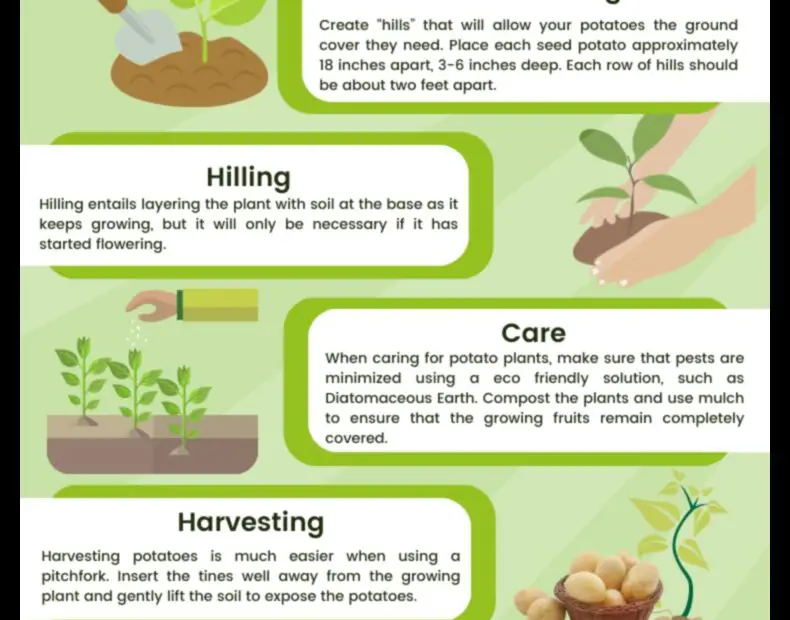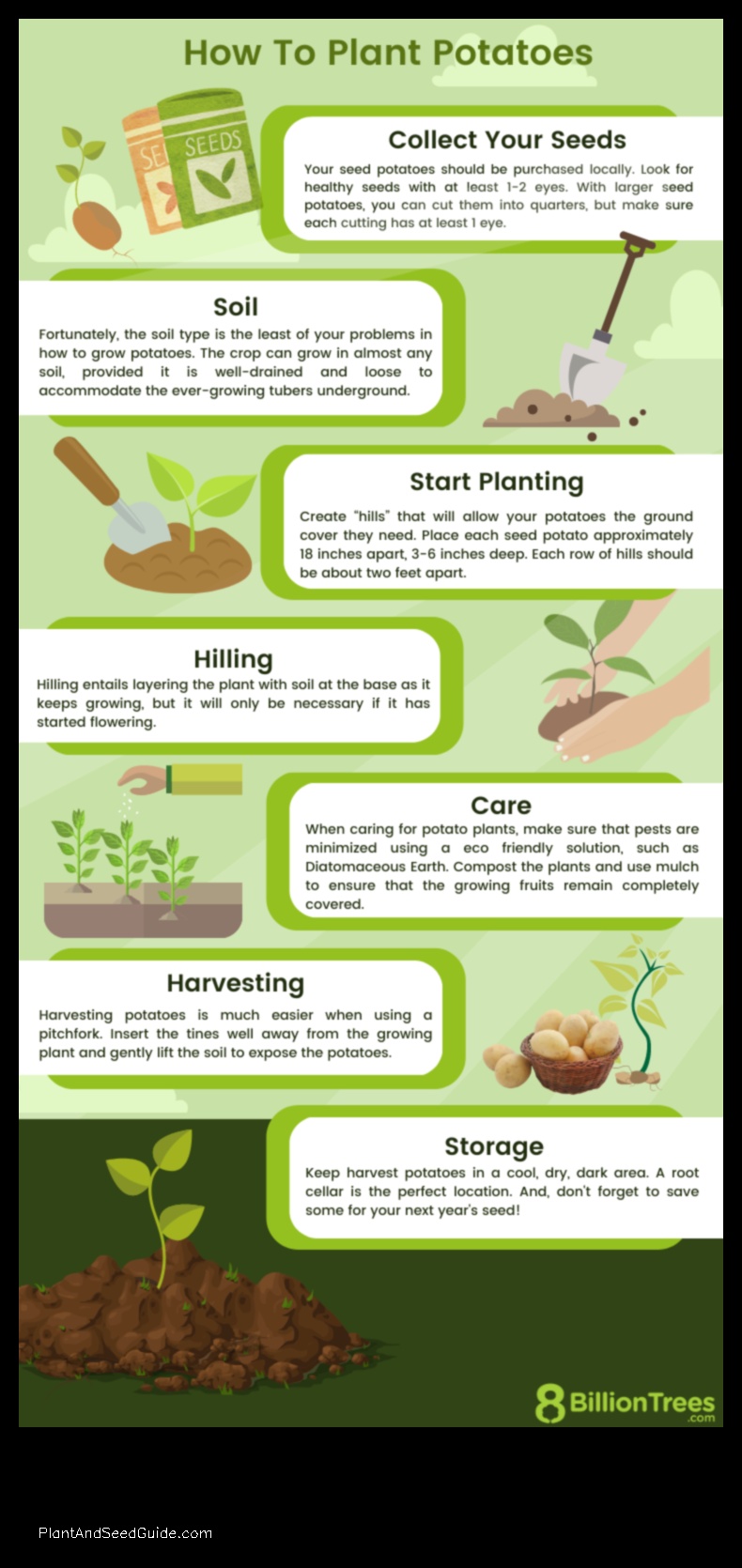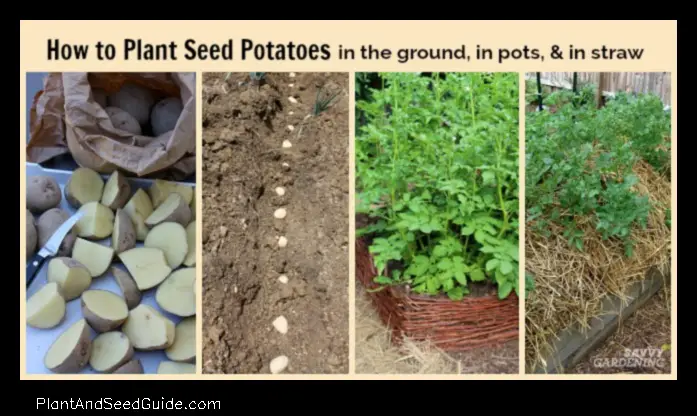

How to Plant Potatoes in Ohio
How to Plant Potatoes in Ohio
Potatoes are a delicious and versatile vegetable that can be grown in a variety of climates. Ohio is a great state for growing potatoes, as it has long, cool summers and plenty of fertile soil.
This guide will walk you through the process of planting potatoes in Ohio, from choosing the right variety to harvesting your crop.
Choosing the Right Variety
There are many different varieties of potatoes to choose from, each with its own unique flavor and characteristics. When choosing a variety of potato to grow in Ohio, you should consider the following factors:
- The climate in your area
- The amount of space you have available
- Your personal preferences
For example, if you live in a warm climate, you may want to choose a variety of potato that is resistant to heat.
If you have limited space, you may want to choose a small variety of potato that is easy to grow..
And if you have a particular taste in potatoes, you may want to choose a variety that is known for its flavor.
Loading... Seconds Left for
Miniature Orchid Terrarium Gallery!

Preparing the Soil
Potatoes grow best in well-drained soil that is rich in organic matter. Before planting your potatoes, you should prepare the soil by:
- Tilling the soil to a depth of 12 inches
- Adding compost or other organic matter to the soil
- Adjusting the pH of the soil to between 5.5 and 6.5
If your soil is not well-drained, you may need to build raised beds for your potatoes. Raised beds will help to improve drainage and prevent your potatoes from rotting.
Planting Potatoes
The best time to plant potatoes in Ohio is in early spring, after the last frost date. Potatoes can be planted directly in the ground or in containers.
If you
are planting potatoes in the ground, you should dig a trench about 6 inches
deep. Place the potatoes in the trench, with the eyes facing up, and cover them with soil. The potatoes should be spaced about 12 inches apart.
If you are planting potatoes in containers, you should use a container that is at least 12 inches deep. Fill the container with soil and plant the potatoes as you would in the ground.
Caring for Potatoes
Potatoes are relatively easy to care for, but there are a few things you can do to help them grow their best:
- Water your potatoes regularly, especially during dry periods
- Fertilize your potatoes with a balanced fertilizer once a month
- Mulch your potatoes to help keep the soil moist and cool
- Hill up your potatoes as they grow to help support the stems
By following these simple tips, you can grow a healthy and bountiful crop of potatoes in Ohio.
Harvesting Potatoes
Potatoes are ready to harvest when the skins are firm and the flesh is firm and white. You can harvest your potatoes by digging them up with a garden fork.
Once y
ou have harvested your potatoes, you should store them in a cool, dry place. Potatoes can be stored for several months if they are properly stored.
Pests and Diseases
Potatoes can be susceptible
| Topic |
Answer |
| Potato |
A starchy tuber that is a root vegetable. |
| Planting |
The process of growing potatoes from seed or tubers. |
| Ohio |
A state in the Midwestern United States. |
| Gardening |
The practice of growing plants for food or pleasure. |
| Vegetable |
A plant or part of a plant that is eaten as food. |

Potatoes are a popular crop in Ohio, and for good reason. They are relatively easy to grow, and they can be used in a variety of dishes. If you are thinking about growing potatoes in Ohio, there are a few things you need to know.
First, you need to choose the right variety of potatoes for your climate. There are many different types of potatoes available, and not all of them will grow well in Ohio. Some good varieties for Ohio include Yukon Gold, Red Pontiac, and Russet Burbank.
Second, you need to prepare the soil properly. Potatoes need well-drained soil that is rich in organic matter. You should also make sure that the soil pH is between 5.5 and 6.5.
Third, you
need to plant the potatoes at the right time. The best time to plant potatoes in Ohio is in early spring, after the last frost.
Fourth, you need to care for the potato plants properly. This includes watering them regularly, weeding the area around them, and controlling pests.
Fifth, you need to harvest the potatoes when they are ripe. The best time to harvest potatoes is when the skins are tough and the flesh is firm.
Finally, yo
u need to store the potatoes properly. Potatoes can be stored in a cool, dry place for several months.
Choosing the Right Potatoes
When choosing potatoes to plant in Ohio, there are a few factors to consider.
- The climate. Potatoes are a cool-weather crop, so they do best in areas with mild winters and cool summers. If you live in a hot climate, you may want to choose a variety of potato that is specifically adapted for warm weather.
- The soil. Potatoes prefer a well-drained, loamy soil. If your soil is heavy clay or sandy, you may need to add compost or other organic matter to improve drainage.
- The pests and diseases. Some varieties of potatoes are more resistant to pests and diseases than others. If you have a history of problems with pests or diseases, you may want to choose a variety that is resistant to those specific problems.
Once you have considered these factors, you can start choosing the right potatoes for your garden. There are many different varieties of potatoes to choose from, so you’re sure to find one that’s perfect for you.
Choosing_the_Right_Potatoes-2">Choosing the Right Potatoes
When choosing potatoes to grow in Ohio, it is important to consider the climate and soil conditions in your area. Potatoes are a cool-season crop and do best in well-drained soil that is rich in organic matter. They are also susceptible to a variety of pests and diseases, so it is important to choose varieties that are resistant to these problems.
Some of the best potatoes to grow in Ohio include:
Russet Burbank: This is a popular variety that is known for its large size and creamy texture. It is a good choice for baking, mashing, and frying.
Yukon Gold: This variety has a yellow flesh and a buttery flavor. It is a good choice for boiling, roasting, and mashing.
Red Pontiac: This variety has a red skin and a white flesh. It is a good choice for boiling, frying, and baking.
White Lady: This variety has a white skin and a white flesh. It is a good choice for boiling, mashing, and frying.
When choosi
ng potatoes to grow, it is also important to consider the maturity date of the variety. Early-maturing varieties are ready to harvest in about 80 days, while late-maturing varieties take up to 120 days to mature. Early-maturing varieties are a good choice for gardeners who want to enjoy fresh potatoes early in the season. Late-maturing varieties are a good choice for gardeners who want to store potatoes for long-term use.
Planting Potatoes
Potatoes can be planted in the spring or fall, but spring is the preferred time for most gardeners. When planting in the spring, wait until the soil has warmed to at least 45 degrees Fahrenheit.
To plant potatoes, dig a trench about 10 inches deep and 3 feet wide. Place the potatoes about 12 inches apart in the trench, with the eyes facing up. Cover the potatoes with soil and water well.
ear:both; margin-top:0em; margin-bottom:1em;">
See also
Discover the Best Companion Plants for Azaleas
Potatoes will sprout in about 2 weeks. Once the plants are about 6 inches tall, hill up the soil around them to help support the stems.
Water the potatoes regularly, especially during dry spells. Fertilize the plants every few weeks with a balanced fertilizer.
Potatoes are ready to harvest when the skins are tough and the flesh is firm. To harvest, dig up the potatoes carefully so as not to damage the tubers.
Store potat
oes in a cool, dry place. They will keep for several months if stored properly.
VCaring for Potatoes
Potatoes are relatively easy to care for, but there are a few things you need to do to ensure that they grow well and produce a good crop.
First, make sure that the plants have plenty of water. Potatoes need about 1 inch of water per week, but they may need more water during hot, dry weather.
Second, fer
tilize the plants regularly. Potatoes need a lot of nutrients, so you should fertilize them every two weeks with a balanced fertilizer.
Third, keep the weeds under control. Weeds compete with potatoes for water, nutrients, and sunlight, so it is important to remove them regularly.
Fourth, protect the plants from pests and diseases. Potatoes are susceptible to a variety of pests and diseases, so it is important to take steps to protect them.
Fifth, harv
est the potatoes when they are mature. Potatoes are ready to harvest when the skins are tough and the flesh is firm.
By following these tips, you can grow healthy, productive potato plants.
Harvesting Potatoes
Harvesting potatoes is a relatively simple process, but there are a few things you need to know in order to do it correctly.
The first s
tep is to wait until the potatoes are fully mature.This means that the skins should be tough and the flesh should be firm..
You can usually tell when potatoes are mature by the size of the tubers. They should be about the size of a golf ball or larger.
Once the potatoes are mature, you can start harvesting them. To do this, carefully dig up the potatoes with a shovel or garden fork. Be careful not to damage the tubers.
Once you have harvested the potatoes, you need to clean them. This can be done by rinsing them off with water. You can also remove any dirt or debris from the potatoes by brushing them with a soft brush.
After the p
otatoes have been cleaned, you need to store them. Potatoes can be stored in a cool, dry place for several months. You can also store them in a root cellar or in a refrigerator.
Here are a few tips for harvesting potatoes:
- Wait until the potatoes are fully mature before harvesting them.
- Dig up the potatoes carefully so as not to damage the tubers.
- Clean the potatoes before storing them.
- Store the potatoes in a cool, dry place.
Stori
ng Potatoes
Storing Potatoes
Potatoes can be stored for several months if they are properly cured and stored. The best way to store potatoes is in a cool, dark, and dry place. A root cellar or basement is ideal, but you can also store potatoes in a cool closet or pantry.
To cure potatoes, you will need to first wash them and remove any damaged or rotting potatoes.
Then, place the potatoes in a single layer in a cardboard box or wooden crate..
Cover the potatoes with a layer of straw or newspaper, and then close the box or crate.
ear:both; margin-top:0em; margin-bottom:1em;">See also
Grow a Fragrant Hydroponic Mint Garden in Your Home



